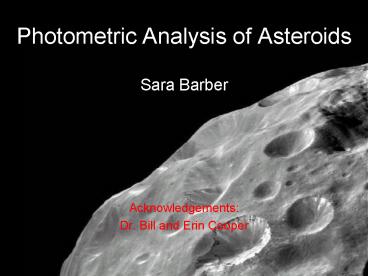Photometric Analysis of Asteroids - PowerPoint PPT Presentation
Title:
Photometric Analysis of Asteroids
Description:
Photometric Analysis of Asteroids Sara Barber Acknowledgements: Dr. Bill and Erin Cooper – PowerPoint PPT presentation
Number of Views:58
Avg rating:3.0/5.0
Title: Photometric Analysis of Asteroids
1
Photometric Analysis of Asteroids
- Sara Barber
- Acknowledgements
- Dr. Bill and Erin Cooper
2
Project Evolution
- Old Project Opposition Effect of Dark Asteroids
- Goal
- Make photometric observations of asteroids with
low reflectivity near opposition - Create lightcurves for these asteroids
- Problem
- CCD malfunction
- New Project Photometric Analysis of Trojan
Asteroids - Goal
- Analyze previously obtained images of Trojan
asteroids - Create lightcurves for these asteroids
3
Motivation
- My Goal Create lightcurves for Trojan asteroids
- Future Goal Combine lightcurves throughout
asteroids orbit to determine 3-D shape - Shape Spin Rate ? Density
- The density could put a limit on the asteroids
composition. - Trojan Composition v.s. Main-Belt Composition
- Different origins within the solar system?
- Better understanding of solar systems evolution
4
Outline
- Trojan Asteroids
- Lightcurves
- Photometry Steps
- CCD Photometry
- Image Processing
- Complications
- Measuring
- Calibration
- Lightcurves
- Results
Preparing for a night of observing.
5
Trojan Asteroids
- Asteroids in orbit around Jupiters 4th and 5th
Lagrange points
6
Lightcurves
- Lightcurve change in brightness throughout
rotation - More illuminated surface area ? brighter
- Less illuminated surface area ? dimmer
7
Photometry
- Photometry technique for measuring an objects
brightness - Steps
- Take exposures
- Process images
- Measure objects brightness
- Calibrate measurements
- Create lightcurve
8
STEP 1 CCD Photometry
- Charged Coupled Device (CCD)
- Photon hits Si substrate photoexcites e-
- 1 photon 1 e-
- Electrons trapped in pixels by electrodes w/
- applied voltage
- Get series of numbers
- that are reconstructed to
- make image
CCD
Electrodes
Conduction Band
CCDTop View
Valence Band
9
STEP 2 Image Processing
- Want uniform background
- Sources of Background Inhomogeneity
- Thermal Signal ? Thermal energy is enough to kick
electrons into conduction band (CCD not cooled
uniformly ? have gradient of thermal signal) - Dark Frame
- Pixel-to-Pixel Variations ? Flaws on CCD chip,
dust shadows - Flat Frame
10
STEP 2 Image Processing
11
(No Transcript)
12
Dark Subtracted
Raw Image
Flat Divided
Reduced Image
13
Images
14
Complications
Asteroid
15
STEP 3 Measuring
- Measure electron count
- within aperture
- Only want electron count
- from source
- Need to subtract count from
- background (scattered moonlight, city lights,
etc.) - Aperture ? Source Background
- Annulus ? Background
- Source Aperture Count - Annulus Count
Star Field
16
STEP 3 Calibration
- We have electron counts, want physical magnitudes
- Observe flux standard stars (stars of well known
magnitude) - Measure e- counts for these stars
- Use linearity of CCD (double e- count double
flux) to calibrate source - Source e- count ? Source magnitude
17
STEP 4 Lightcurve
- Plot brightness vs. exposure time
18
STEP 4 Lightcurve
- Phase Lightcurve
- Use previously published rotation periods to plot
brightness vs. phase
19
Results
20
Questions?

